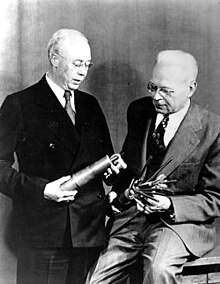Lloyd Espenschied
Lloyd Espenschied | |
|---|---|
 Espenschied (at left) with Herman Andrew Affel, c. 1950–1960 | |
| Born | April 27, 1889[1] |
| Died | June 21, 1986 (aged 97) |
| Awards | IEEE Medal of Honor (1940) |
| Scientific career | |
| Fields | Electrical engineering |
Lloyd Espenschied (April 27, 1889 – June 21, 1986) was an American electrical engineer who invented the modern coaxial cable with Herman Andrew Affel.[2]
Early life and education
Lloyd Espenschied was born in Baden, North St. Louis, Missouri, on April 27, 1889, the son of Frederick F. Espenschied (January 3, 1856 – July 22, 1908) and Clara M. Espenschied (January 14, 1856 – March 26, 1947).[2][3][4][5] Fred was an 1875 graduate of the St. Louis Law School, which is today part of Washington University. He served as private secretary to his brother-in-law, Mayor Henry von Overstolz.[4] Under Mayor David R. Francis, Fred later became City Treasurer before becoming State Senator from 1891 to 1893. Lloyd had two siblings: a brother Frederic, and a sister Clare.[4]
Espenschied moved to Brooklyn, New York during his childhood.[4] By 1904, he was already exploring wireless telegraphy and became an amateur radio operator. He entered the Pratt Institute in 1907, and obtained a certificate of applied engineering. During summers, he worked for the United Wireless Telegraph Company.[6]
Career
Espenschied worked as an engineer for Telefunken Wireless Telegraph Company during 1909–1910.[7][8] He later worked for the American Telephone and Telegraph Company and later Bell Telephone Laboratories in various capacities from 1910 to 1937.[8] In the 17 years preceding his retirement in 1954, Espenschied was staff research consultant and consulting engineer at Bell Telephone Laboratories.[6]
Beginning in 1916, Espenschied worked with Herman Affel and other colleagues on a carrier system from Baltimore to Pittsburgh. This work led to Espenschied and Affel creating the first modern coaxial cable. Their invention paved the way for television transmission.[7][9] The cable advanced long distance telephone service, making it possible to carry thousands of simultaneous phone calls on long distance circuits. In 1930, he applied for a patent on a device based on a mathematical analysis used by the radio altimeter invented by William Littell Everitt at Ohio State University.[10][11][12] Espenschied was the holder of more than 100 patents in both wire and radio communication systems.[2]
Personal life and death
In April 1912, Espenschied married another Pratt student, Ethel Fairfield Lovejoy, known as "Lovey".[6] They were married for over 60 years, and had two children.[6]
An avid genealogist, Espenschied visited Germany for the purpose of extensive research. While abroad, he was able to ascertain the German background of his family. Returning to St. Louis in 1937–38 to trace his American family pattern, he discovered that the original Louis Espenschied wagon plant created by his grandfather was gone and that the Luedinghaus-Espenschied Wagon Company had been deserted.[4][13]
Espenschied was an isolationist and opposed American involvement in World War II. When interviewed during the war by a member of the United States Department of War, he stated: "We were led into this mess largely by British propaganda, Jewish propaganda, Roosevelt imperialism."[14]
Espenschied died on June 21, 1986, at a nursing home in Holmdel, New Jersey, at the age of 97.[2][6]
References
- ^ "Draft Registration Card". Selective Service System. April 1942. Retrieved August 22, 2020 – via fold3.com.
- ^ a b c d "Lloyd Espnschied, One Of The Inventors Of The Coaxial Cable". New York Times. July 4, 1986. Retrieved 2011-11-18.
Lloyd Espenschied, co-inventor of the coaxial cable, which paved the way for television transmission, died June 21 at a nursing home in Holmdel, N.J. He was 97 years old and lived in Kew Gardens, Queens. Mr. Espenschied, an electrical engineer, was a member of the technical staff at the American Telephone and Telegraph Company Bell Laboratories and holder of more than 100 patents in both wire and radio communications systems. He retired as staff research consultant in 1954, after 43 years with the company.
- ^ Froehlich, Fritz E.; Kent, Allen (1994). The Froehlich/Kent Encyclopedia of Telecommunications. Vol. 7. New York: Marcel Dekker, Inc. p. 361. ISBN 0-8247-2905-6.
- ^ a b c d e Espenschied, Lloyd (January 5, 1962). "Louis Espenschied and His Family". Missouri Historical Society Bulletin (St. Louis, Missouri). XVIII (2): 87–103.
- ^ "Family Group Sheet for Louis Espenschied/ (F2812)". iwhipple.org. Archived from the original on 2016-02-05. Retrieved 2016-01-31.
- ^ a b c d e Espenschied, Lloyd • 1889–1986. The Journal of the Acoustical Society of America 81, 1205 (1987); https://doi.org/10.1121/1.394650
- ^ a b "Lloyd Espenschied". IEEE. Retrieved 2011-11-15.
- ^ a b Espenschied, Lloyd. Lloyd Espenschied Papers.
- ^ "Lloyd Espenschied Papers". Smithsonian Institution. Retrieved 2011-11-18.
Espenschied was born in St. Louis and graduated from Pratt Institute in electrical engineering, 1909; on staff of the Telefunken Wireless Telegraph Company, 1909-10; worked for American Telephone and Telegraph Company in various capacities, 1910-34; directed high-frequency transmission development for Bell Telephone Laboratories, 1934-37. ...
- ^ Sandretto, Peter C. (1943). Principles of Aeronautical Radio Engineering. New York: McGraw-Hill. p. 215.
- ^ "Towers Flash Radio Beams To Detect Warplanes" Popular Mechanics, September 1941
- ^ Solving the problem of fog flying. New York City: Daniel Guggenheim Fund for the Promotion of Aeronautics, p.29, 1929.p
- ^ Bennitt, Mark; Stockbridge, Frank Parker (1905-01-01). History of the Louisiana Purchase Exposition: Comprising the History of the Louisiana Territory, the Story of the Louisiana Purchase and a Full Account of the Great Exposition, Embracing the Participation of the States and Nations of the World, and Other Events of the St. Louis World's Fair of 1904; Comp. from Official Sources. Universal exposition publishing Company.
- ^ Jon Gertner (15 March 2012). The Idea Factory: Bell Labs and the Great Age of American Innovation. Penguin Group US. ISBN 978-1-101-56108-9.
